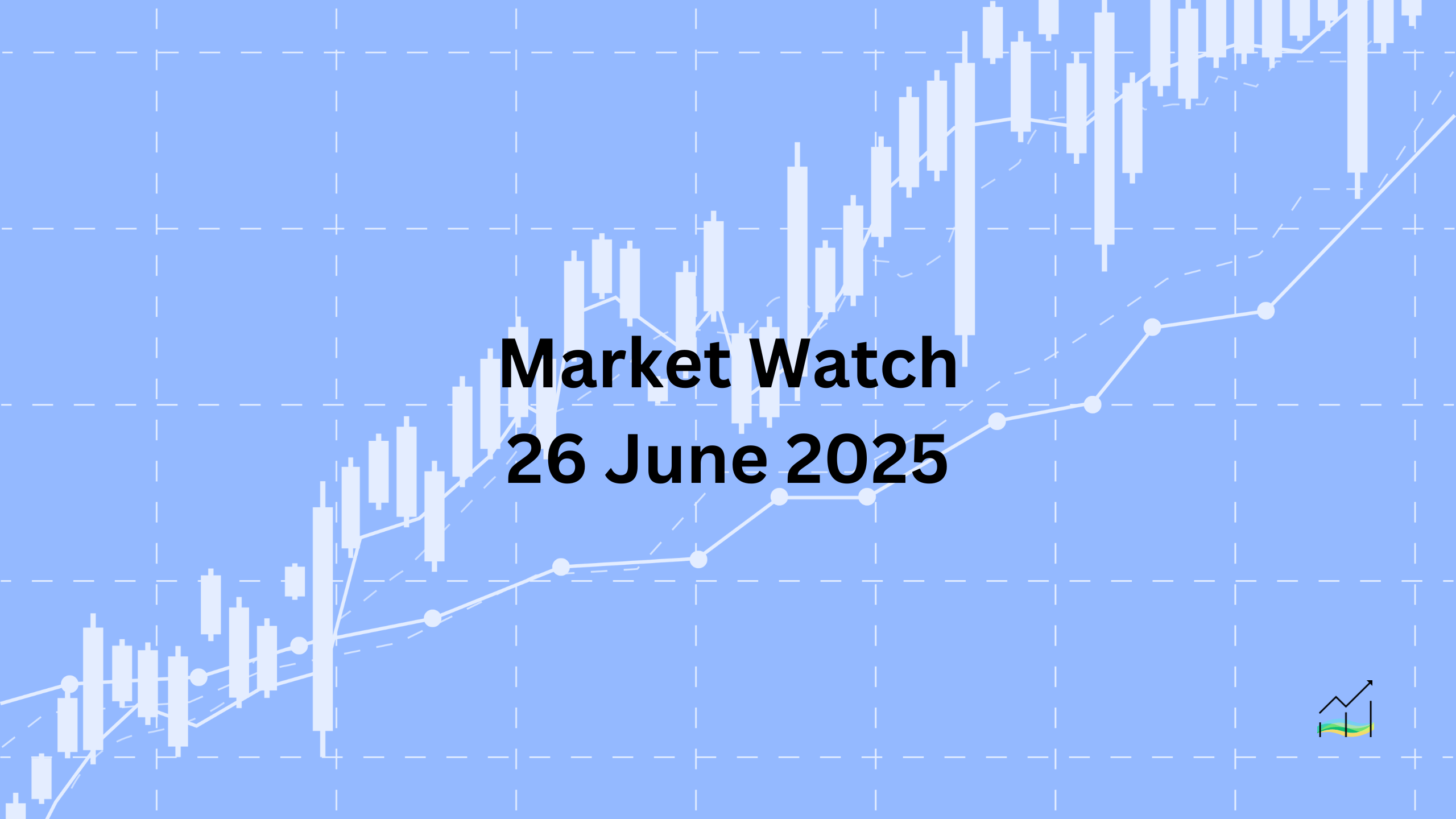26/06/2025 Market Watch

Dollar Tumbles on Potential Fed Leadership Shift
Key Takeaways:
- The US dollar is significantly weaker today, pressured by potential leadership changes at the Federal Reserve.
- Expectations for rate cuts this year have increased, affecting investor confidence.
- Equity markets mostly advanced, despite mixed performances in Asia.
- US Treasury yields continued to decline, influencing gold and oil markets.
The US dollar experienced sharp declines today, marking a notable drop against nearly all major currencies. Reports suggesting a potential successor to Federal Reserve Chair Jerome Powell might be named in the coming months unsettled investors, who generally dislike direct political interference with monetary policy. This development has amplified speculation about upcoming interest rate cuts, with markets now pricing in around 63 basis points of easing by year-end—the highest anticipated easing since early May.
Investor caution was further compounded by month-end and quarter-end flows, along with impending uncertainties around the reciprocal tariff reprieve expiring on July 9. This blend of factors collectively intensified bearish sentiment toward the greenback.
Despite currency volatility, most global equity markets maintained positive momentum. Europe's Stoxx 600 managed moderate gains after yesterday's losses, while US index futures showed similar resilience, indicating potential for a positive open. However, Asian markets were more mixed, with notable declines in China, Hong Kong, and Australia.
Bond yields broadly softened, with Europe's benchmark rates slipping marginally. In the US, the 10-year Treasury yield edged lower for the fifth consecutive session, reflecting increased bets on a dovish Fed trajectory. Consequently, gold found modest support, remaining stable within recent ranges, while oil prices, particularly August WTI, continued trading within constrained boundaries established earlier in the week.
United States of America
Overview
The US dollar continues its downward slide, marking another notable drop today. The Dollar Index opened lower for the second time this week, establishing fresh three-year lows around the 97.00 mark during European trading. The currency's technical outlook offers limited immediate support, potentially opening room for further losses towards the 95.00 area. However, traders are aware of stretched intraday momentum signals, with the lower Bollinger Band currently hovering near 97.40.
Today’s trading session is packed with significant economic events, highlighted by the Treasury's issuance of seven-year notes, following yesterday's poorly received five-year note auction. The market's attention will also shift toward May's goods trade balance, likely influenced by increased US imports amid postponed reciprocal tariffs, mirroring strong exports recently reported by several Asian economies.
Meanwhile, durable goods orders for May are expected to show inflated figures due to Boeing orders, but when excluding aircraft and defense, analysts anticipate another consecutive monthly decline. This weakness also extends to core durable goods shipments, an essential indicator of capital expenditure trends, expected to decline for the second straight month. GDP revisions for the first quarter are unlikely to significantly impact sentiment, as the focus remains forward-looking.
Following Federal Reserve Chair Powell's recent congressional testimony, market expectations for an immediate July rate cut remain low, around 15%, largely unchanged since the latest jobs report. Investors are instead setting their sights on a potential move in September as a more realistic scenario.
Economic Drivers
- Expectations of continued Fed rate cuts weigh heavily on the dollar.
- Increased import activity due to postponement of reciprocal tariffs impacts trade dynamics.
- Weakness in underlying durable goods orders and core shipments signals subdued capital investment.
Data and Events
- 26 June 2025: Final GDP.
- 26 June 2025: Unemployment Claims
- 26 June 2025: Durable Goods Orders.
- 26 June 2025: Pending Home Sales.
Price Action
- The Dollar Index (DXY) gapped lower again, breaching the critical 97.00 level.
- Limited technical support ahead of potential moves towards 95.00.
- Intraday momentum indicators indicate possible short-term oversold conditions.
Key Points:
- US dollar declines sharply, breaking key technical levels.
- Durable goods and trade data closely watched for economic signals.
- Market shifts attention to September as a realistic timeline for Fed rate cuts.
- Weak treasury auctions suggest cautious investor sentiment.
Canada
Overview
The Canadian dollar strengthened modestly today, rebounding slightly against a weaker US dollar. After briefly trading as high as CAD1.3755 yesterday, coinciding with the close of European markets, the US dollar retreated in North American trading, settling into a volatile consolidation just above CAD1.3720. Today, the greenback slipped further, revisiting Tuesday’s lows around CAD1.3680.
Despite the recent decline of the US dollar, the Canadian currency has generally lagged its G10 peers, reflecting underlying cautious sentiment. The Canadian dollar remains notably above its annual low near CAD1.3540, recorded earlier this month.
Market attention now shifts to Canada's upcoming economic data, specifically the GDP report for April. Forecasting quarterly economic activity from monthly GDP figures has proven challenging due to discrepancies between the two measurements. For instance, the combined monthly GDP data in Q1 suggested modest growth of around 0.3%, yet the official quarterly growth rate came in stronger, at an annualized 2.2%, equivalent to approximately 0.55% growth quarter-over-quarter.
A flat reading for April would imply the economy contracted slightly on a monthly basis over the past three months. Current consensus forecasts project a notable contraction of around 1% annualized for Q2. The Bank of Canada has indicated that most of its monetary easing measures are behind it, with only minimal further easing expected this year.
Economic Drivers
- Anticipated slowing of Canadian economic growth in Q2.
- Bank of Canada's front-loaded monetary easing nearing completion.
- Swap markets predict one more potential rate cut by year-end.
Data and Events
No major economic releases are scheduled today.
Price Action
- USD/CAD retreats after peaking around CAD1.3755, testing support near CAD1.3680.
- Canadian dollar remains weaker compared to other G10 currencies amid broader USD declines.
- Annual low near CAD1.3540 remains a critical support reference.
Key Points:
- Canadian dollar strengthens slightly but underperforms G10 peers.
- Market cautiously awaits key GDP data release for insights on economic health.
- Bank of Canada signals approaching end to monetary easing cycle.
Europe
Overview
The euro extended its recent rally, hitting a fresh three-year high against the US dollar. After briefly surpassing $1.1665 yesterday, the currency surged convincingly beyond $1.1700 in today's European trading, reaching highs near $1.1745. This rapid move reflects robust bullish momentum, with technical indicators suggesting potential for further gains.
The euro’s recent strength coincides with a narrowing gap in yield differentials between US and German government bonds. The premium of US two-year bond yields over their German counterparts has dropped from 213 basis points at the beginning of last week to 193 basis points currently, marking the lowest level since late April. This narrowing of yield spreads has occurred consistently over the last five sessions.
Similarly, the yield spread on 10-year bonds has tightened significantly, declining from approximately 195 basis points two weeks ago to around 173 basis points now, again reflecting levels last observed at the end of April. After several days of steady narrowing, today’s trading shows signs of stabilisation in these spreads, suggesting markets may pause to reassess the recent moves.
Investors are likely to watch these yield differentials closely, as they are critical indicators for currency movements and can significantly influence investor sentiment toward the euro versus the US dollar.
Economic Drivers
- Narrowing yield spreads between US and German bonds, supporting euro appreciation.
- Reduced expectations of aggressive Federal Reserve rate hikes relative to ECB policy.
- Continued investor appetite for euro-denominated assets amid broader dollar weakness.
Data and Events
No major economic releases are scheduled today.
Price Action
- EUR/USD decisively breaks through the $1.1700 barrier, touching new multi-year highs around $1.1745.
- Upper Bollinger Band around $1.1690, indicating potential short-term overbought conditions.
- Weekly charts suggest next meaningful resistance around the $1.19-$1.20 region.
Key Points:
- Euro reaches fresh three-year highs above $1.1700.
- Significant narrowing of US-German yield spreads boosts euro strength.
- Market attention focused on potential further upside toward $1.19-$1.20 resistance area.
© 2025 SKONE Enterprise (003319453-V). All rights reserved.
The content on this site is for informational purposes only and does not constitute financial advice.


